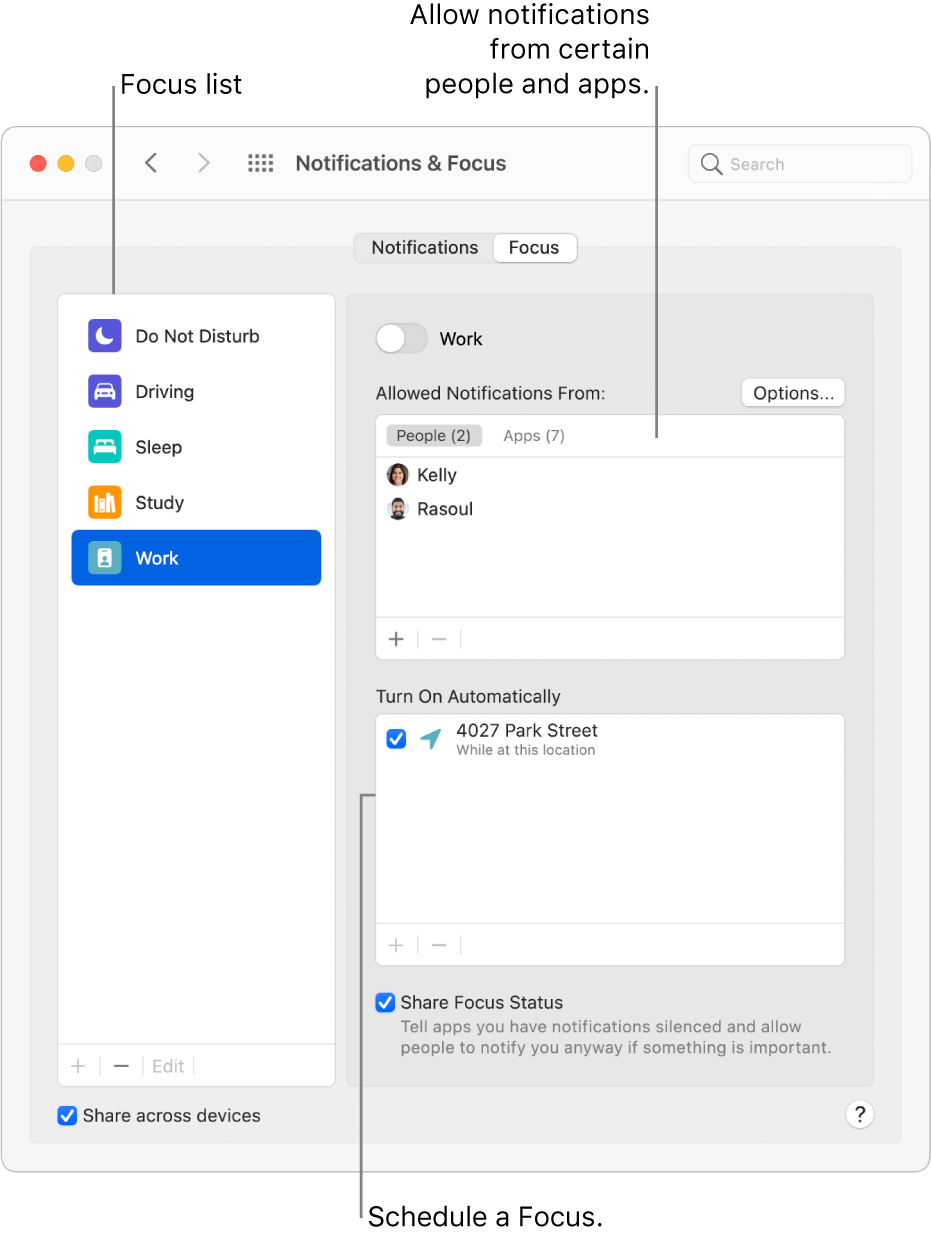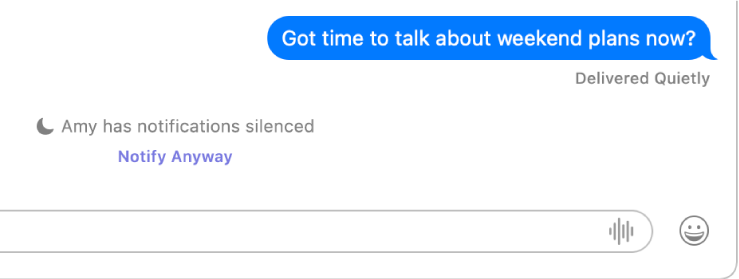
Set up a Focus on Mac
When you need to stay on task and minimise distractions, use Focus. You can use a Focus to pause and silence all notifications or allow only certain notifications — for example, ones from colleagues on an urgent project. You can also share that you’ve silenced notifications so contacts know you’re busy.

Tip: Need to quickly silence all notifications? Turn on the Do Not Disturb Focus in Control Centre.
Add or remove a Focus
On your Mac, choose Apple menu

 .
.Click Focus, then do any of the following:
Add a provided Focus: Click the Add button
 at the bottom of the Focus list, then choose a Focus, such as Gaming or Work.
at the bottom of the Focus list, then choose a Focus, such as Gaming or Work.Create a custom Focus: Click the Add button
 at the bottom of the Focus list, then choose Custom. Enter a name, select a colour and icon, then click Add. For example, you might create a Study Focus. You can create up to ten.
at the bottom of the Focus list, then choose Custom. Enter a name, select a colour and icon, then click Add. For example, you might create a Study Focus. You can create up to ten.Change a custom Focus: Select the Focus in the list, then click Edit at the bottom of the Focus list. Change the name, colour or icon, then click Done.
Remove a Focus: Select the Focus in the list, then click the Remove button
 at the bottom of the Focus list.
at the bottom of the Focus list.A custom Focus is deleted. A provided Focus, such as Reading or Mindfulness, is removed from the list but is still available to add again later.
If you keep Focus up to date across your Apple devices, the changes you make on your Mac are reflected on your other devices.
Choose which notifications to allow
You can specify which notifications are shown when a Focus is active — for example, notifications from certain people and apps, time-sensitive notifications or notifications for phone calls received on your Mac.
Note: Some apps, such as Calendar, have time-sensitive notifications. To ensure you receive these notifications, select the option to allow them.
On your Mac, choose Apple menu

 .
.Click Focus, then select a Focus.
In the Allowed Notifications From list, do any of the following:
Allow notifications from certain people: Click People, click the Add button
 , then select one or more contacts. For example, for the Gaming Focus, you might select the friends you usually play with in multiplayer games.
, then select one or more contacts. For example, for the Gaming Focus, you might select the friends you usually play with in multiplayer games.To remove a person from the list, select the person, then click the Remove button
 .
.Allow notifications from certain apps: Click Apps, click the Add button
 , then select one or more apps. For example, for the Work Focus, you might allow notifications only from the apps you need to do your work.
, then select one or more apps. For example, for the Work Focus, you might allow notifications only from the apps you need to do your work.To remove an app from the list, select the app, then click the Remove button
 .
.Allow notifications for events or tasks that require your immediate attention: Click Options, then select “Allow time-sensitive notifications”. (Make sure you also select the option that allows apps to send these notifications in Notifications preferences.)
Allow notifications for phone calls: Click Options, select “Allow calls from,” then click the pop-up menu and choose an option. You can receive notifications for calls from everyone, only people or a specific group in Contacts or only people in your Favourites on iPhone.
Allow notifications for repeated phone calls: Click Options, then select “Allow repeated calls” to receive notifications from anyone who calls two or more times within three minutes.
The Gaming Focus is set by default to turn on whenever a Bluetooth game controller is connected with your Mac. To receive notifications when the Gaming Focus is on, make sure you specify people or apps.
Schedule a Focus to turn on or off automatically
You can schedule a Focus to automatically turn on or off at certain times, when you arrive at or leave certain locations, or when you open or close certain apps.
On your Mac, choose Apple menu

 .
.Click Focus, then select a Focus.
In the Turn On Automatically list, click the Add button
 , then choose whether to schedule the Focus based on time, location or app.
, then choose whether to schedule the Focus based on time, location or app.When you schedule a Focus based on location, the Focus turns on when you arrive at the location and turns off when you leave.
When you schedule a Focus based on app, the Focus turns on when you open the app and turns off when you close it.
In the Automation window, choose times and days, search for a location or choose an app, then click Add.
You must have Location Services enabled in Privacy preferences to use a location. The Gaming Focus is set by default to turn on whenever a Bluetooth game controller is connected with your Mac.
You can use different types of automations for a Focus; it automatically turns on or off based on each automation.
If you want to change an automation, Control-click it in the list, then choose Edit. To temporarily stop using an automation, deselect its tickbox in the list. To delete an automation, select it in the list, then click the Remove button ![]() .
.
Tip: You can quickly turn a Focus on or off in Control Centre. Or click the button for the Focus located at the top of Focus preferences. The button changes colour to indicate that the Focus is active.
Share your Focus status
You can set an option that lets apps indicate to contacts who send you a message that you’ve silenced notifications (they don’t see which Focus you’re using). If something’s important, they can choose to notify you anyway.

On your Mac, choose Apple menu

 .
.Click Focus, then select a Focus.
Select Share Focus Status.
Keep Focus up to date across your Apple devices
When you’re signed in with the same Apple ID on all your Apple devices, any changes you make to Focus are reflected on your other devices, and turning a Focus on or off on one device turns it on or off on your other devices.
On your Mac, choose Apple menu

 .
.Click Focus, then select “Share across devices” at the bottom of the Focus list. (The option is selected by default.)